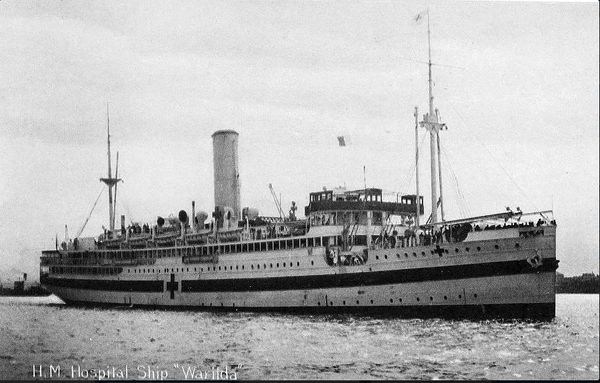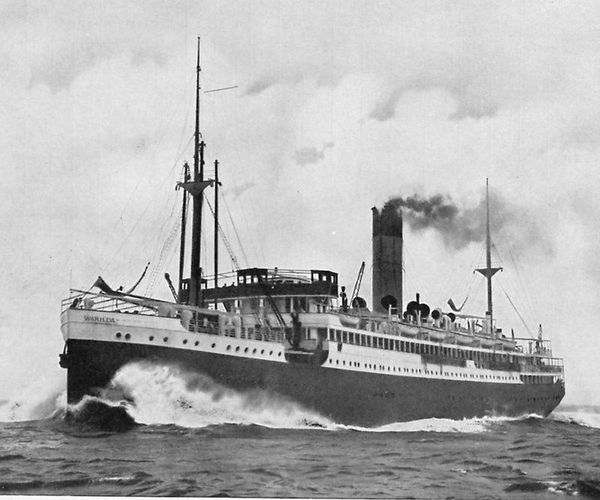Difference between revisions of "HMAT A69 Warilda"
From Our Contribution
| Line 7: | Line 7: | ||
| image = [[File:HMAT_A69_Warilda.jpg|border|600px]] | | image = [[File:HMAT_A69_Warilda.jpg|border|600px]] | ||
| − | | caption = | + | | caption = www.wrecksite.eu |
| image2 = [[File:HMAT_Warilda_1.jpg|border|600px]] | | image2 = [[File:HMAT_Warilda_1.jpg|border|600px]] | ||
| caption2 = Wikipedia | | caption2 = Wikipedia | ||
| Line 38: | Line 38: | ||
==Remarks== | ==Remarks== | ||
| − | Built for the Adelaide Steamship Company. Could carry almost 400 passengers in three classes, she was converted into a troopship in August 1914 and made three journeys from Australia in this form. | + | Built for the Adelaide Steamship Company. Could carry almost 400 passengers in three classes, she was converted into a troopship in August 1914 and made three journeys from Australia in this form. Converted again in 1916, this time to be a Hospital Ship and she served as such from 25 Jul 1916 till 3 Aug 1918. |
| − | |||
| − | |||
| − | |||
On 3rd August 1918 while transporting the sick and wounded from Le Havre to Southampton, the HS Warilda was torpedoed and sunk by the German submarine UC-49. This was despite being marked clearly with the Red Cross; as with a number of other hospital ships torpedoed during the war, Germany claimed the ships were also carrying arms. | On 3rd August 1918 while transporting the sick and wounded from Le Havre to Southampton, the HS Warilda was torpedoed and sunk by the German submarine UC-49. This was despite being marked clearly with the Red Cross; as with a number of other hospital ships torpedoed during the war, Germany claimed the ships were also carrying arms. | ||
| − | |||
| − | Those lost at sea in the Channel are commemorated on the Hollybrook Memorial, Southampton. | + | The ship sank in about two hours, and of the 801 persons on board, 123 people perished including 19 Australians and the Deputy Chief Controller of the Queen Mary’s Army Auxiliary Corp, Mrs Violet Long. Those lost at sea in the Channel are commemorated on the Hollybrook Memorial, Southampton. |
==Medical Staff== | ==Medical Staff== | ||
| − | ==Fremantle to Plymouth 1 June - 18 July 1916== | + | ===Fremantle to Plymouth 1 June - 18 July 1916=== |
*[[Francis William Singleton]] | *[[Francis William Singleton]] | ||
==Soldiers carried== | ==Soldiers carried== | ||
| − | ==Fremantle to Port Suez 16 February - 13 March 1916== | + | ===Fremantle to Port Suez 16 February - 13 March 1916=== |
*[[Charles Blunt]] | *[[Charles Blunt]] | ||
*[[Sydney Chadwick McDonald]] | *[[Sydney Chadwick McDonald]] | ||
| Line 62: | Line 58: | ||
*[[William Robert Rigby]] | *[[William Robert Rigby]] | ||
| − | ==Fremantle to Plymouth 1 June - 18 July 1916== | + | ===Fremantle to Plymouth 1 June - 18 July 1916=== |
*[[Lyndon Vivian Brady]] | *[[Lyndon Vivian Brady]] | ||
*[[Reginald Samuel Roquerbre Dutton]] | *[[Reginald Samuel Roquerbre Dutton]] | ||
| − | ==France to England 28 Jan 1917== | + | ===France to England 28 Jan 1917=== |
*[[Charles Edward Parkin]] | *[[Charles Edward Parkin]] | ||
| − | ==Rouen to England 8 March 1917== | + | ===Rouen to England 8 March 1917=== |
*[[John Hugh Jones]] | *[[John Hugh Jones]] | ||
| − | ==Le Havre to England 3 May 1917== | + | ===Le Havre to England 3 May 1917=== |
*[[Frank Halliday]] | *[[Frank Halliday]] | ||
| − | ==France to England 25 May 1917== | + | ===France to England 25 May 1917=== |
*[[Edward Patrick Thomas O'Brien]] | *[[Edward Patrick Thomas O'Brien]] | ||
| − | ==France to England 25 September 1917== | + | ===France to England 25 September 1917=== |
*[[William Thomson]] | *[[William Thomson]] | ||
| − | ==France to England 14 March 1918== | + | ===France to England 14 March 1918=== |
*[[John Harold Coffen]] | *[[John Harold Coffen]] | ||
| − | ==France to England 31 May 1918== | + | ===France to England 31 May 1918=== |
*[[Harry Hodgson]] | *[[Harry Hodgson]] | ||
[[Category:Ships]] | [[Category:Ships]] | ||
Revision as of 02:23, 1 July 2019
 www.wrecksite.eu | |
 Wikipedia | |
| History | |
|---|---|
| Name | HMAT A69 Warilda |
| Builder/Built | 1912 W Beardmore & Co Ltd, Dalmuir |
| Type | Passenger / cargo ship |
| Displacement | 7,713 tons |
| Speed | 14.5 knots |
Contents
- 1 Remarks
- 2 Medical Staff
- 3 Soldiers carried
- 3.1 Fremantle to Port Suez 16 February - 13 March 1916
- 3.2 Fremantle to Plymouth 1 June - 18 July 1916
- 3.3 France to England 28 Jan 1917
- 3.4 Rouen to England 8 March 1917
- 3.5 Le Havre to England 3 May 1917
- 3.6 France to England 25 May 1917
- 3.7 France to England 25 September 1917
- 3.8 France to England 14 March 1918
- 3.9 France to England 31 May 1918
Remarks
Built for the Adelaide Steamship Company. Could carry almost 400 passengers in three classes, she was converted into a troopship in August 1914 and made three journeys from Australia in this form. Converted again in 1916, this time to be a Hospital Ship and she served as such from 25 Jul 1916 till 3 Aug 1918.
On 3rd August 1918 while transporting the sick and wounded from Le Havre to Southampton, the HS Warilda was torpedoed and sunk by the German submarine UC-49. This was despite being marked clearly with the Red Cross; as with a number of other hospital ships torpedoed during the war, Germany claimed the ships were also carrying arms.
The ship sank in about two hours, and of the 801 persons on board, 123 people perished including 19 Australians and the Deputy Chief Controller of the Queen Mary’s Army Auxiliary Corp, Mrs Violet Long. Those lost at sea in the Channel are commemorated on the Hollybrook Memorial, Southampton.